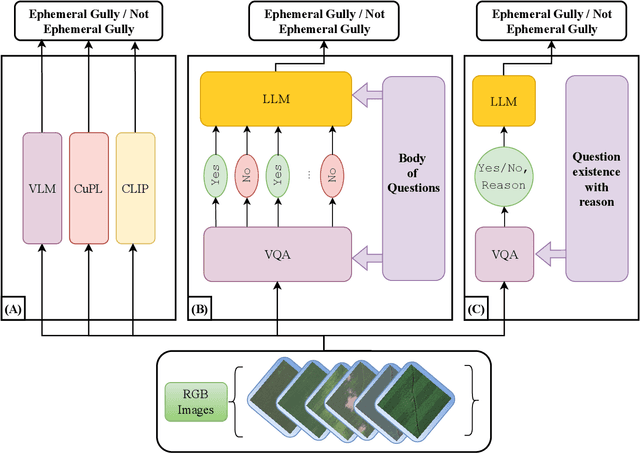Gbenga Omotara
The Fourth Monocular Depth Estimation Challenge
Apr 24, 2025Abstract:This paper presents the results of the fourth edition of the Monocular Depth Estimation Challenge (MDEC), which focuses on zero-shot generalization to the SYNS-Patches benchmark, a dataset featuring challenging environments in both natural and indoor settings. In this edition, we revised the evaluation protocol to use least-squares alignment with two degrees of freedom to support disparity and affine-invariant predictions. We also revised the baselines and included popular off-the-shelf methods: Depth Anything v2 and Marigold. The challenge received a total of 24 submissions that outperformed the baselines on the test set; 10 of these included a report describing their approach, with most leading methods relying on affine-invariant predictions. The challenge winners improved the 3D F-Score over the previous edition's best result, raising it from 22.58% to 23.05%.
A Zero-Shot Learning Approach for Ephemeral Gully Detection from Remote Sensing using Vision Language Models
Mar 03, 2025



Abstract:Ephemeral gullies are a primary cause of soil erosion and their reliable, accurate, and early detection will facilitate significant improvements in the sustainability of global agricultural systems. In our view, prior research has not successfully addressed automated detection of ephemeral gullies from remotely sensed images, so for the first time, we present and evaluate three successful pipelines for ephemeral gully detection. Our pipelines utilize remotely sensed images, acquired from specific agricultural areas over a period of time. The pipelines were tested with various choices of Visual Language Models (VLMs), and they classified the images based on the presence of ephemeral gullies with accuracy higher than 70% and a F1-score close to 80% for positive gully detection. Additionally, we developed the first public dataset for ephemeral gully detection, labeled by a team of soil- and plant-science experts. To evaluate the proposed pipelines, we employed a variety of zero-shot classification methods based on State-of-the-Art (SOTA) open-source Vision-Language Models (VLMs). In addition to that, we compare the same pipelines with a transfer learning approach. Extensive experiments were conducted to validate the detection pipelines and to analyze the impact of hyperparameter changes in their performance. The experimental results demonstrate that the proposed zero-shot classification pipelines are highly effective in detecting ephemeral gullies in a scenario where classification datasets are scarce.
COVID-19 detection from pulmonary CT scans using a novel EfficientNet with attention mechanism
Mar 27, 2024



Abstract:Manual analysis and diagnosis of COVID-19 through the examination of Computed Tomography (CT) images of the lungs can be time-consuming and result in errors, especially given high volume of patients and numerous images per patient. So, we address the need for automation of this task by developing a new deep learning model-based pipeline. Our motivation was sparked by the CVPR Workshop on "Domain Adaptation, Explainability and Fairness in AI for Medical Image Analysis", more specifically, the "COVID-19 Diagnosis Competition (DEF-AI-MIA COV19D)" under the same Workshop. This challenge provides an opportunity to assess our proposed pipeline for COVID-19 detection from CT scan images. The same pipeline incorporates the original EfficientNet, but with an added Attention Mechanism: EfficientNet-AM. Also, unlike the traditional/past pipelines, which relied on a pre-processing step, our pipeline takes the raw selected input images without any such step, except for an image-selection step to simply reduce the number of CT images required for training and/or testing. Moreover, our pipeline is computationally efficient, as, for example, it does not incorporate a decoder for segmenting the lungs. It also does not combine different backbones nor combine RNN with a backbone, as other pipelines in the past did. Nevertheless, our pipeline still outperforms all approaches presented by other teams in last year's instance of the same challenge, at least based on the validation subset of the competition dataset.
High-Throughput and Accurate 3D Scanning of Cattle Using Time-of-Flight Sensors and Deep Learning
Aug 07, 2023Abstract:We introduce a high throughput 3D scanning solution specifically designed to precisely measure cattle phenotypes. This scanner leverages an array of depth sensors, i.e. time-of-flight (Tof) sensors, each governed by dedicated embedded devices. The system excels at generating high-fidelity 3D point clouds, thus facilitating an accurate mesh that faithfully reconstructs the cattle geometry on the fly. In order to evaluate the performance of our system, we have implemented a two-fold validation process. Initially, we test the scanner's competency in determining volume and surface area measurements within a controlled environment featuring known objects. Secondly, we explore the impact and necessity of multi-device synchronization when operating a series of time-of-flight sensors. Based on the experimental results, the proposed system is capable of producing high-quality meshes of untamed cattle for livestock studies.
 Add to Chrome
Add to Chrome Add to Firefox
Add to Firefox Add to Edge
Add to Edge